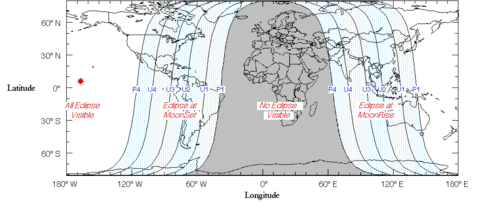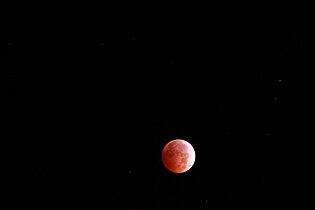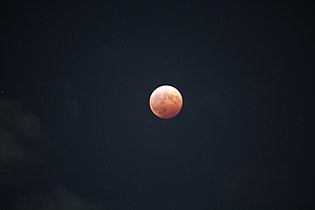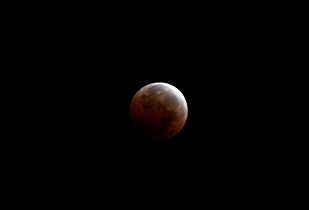October 2014 lunar eclipse
| Total lunar eclipse[1] October 8, 2014 | |
|---|---|
 Loleta, California, 10:56 UTC | |
Ecliptic north up The moon passes right to left (west to east) through the Earth's shadow | |
| Saros (and member) | 127 (42 of 72) |
| Gamma | 0.3827 |
| Duration (hr:mn:sc) | |
| Totality | 58:50 |
| Partial | 3:19:31 |
| Penumbral | 5:18:03 |
| Contacts (UTC) | |
| P1 | 8:15:36 |
| U1 | 9:14:48 |
| U2 | 10:25:09 |
| Greatest | 10:54:35 |
| U3 | 11:23:59 |
| U4 | 12:34:19 |
| P4 | 13:33:39 |
A total lunar eclipse took place on October 8, 2014. It is the second of two total lunar eclipses in 2014, and the second in a tetrad (four total lunar eclipses in series). Other eclipses in the tetrad are those of April 15, 2014, April 4, 2015, and September 28, 2015.
Visibility and appearance

The eclipse was visible in its entirety over the Northern Pacific. Viewers in North America experienced the eclipse after midnight on Wednesday, October 8, and the eclipse was visible from the Western Pacific, Australia, Indonesia, Japan, and Eastern Asia after sunset on the evening of October 8. Many areas of North America experienced a selenelion, able to see both the sun and the eclipsed moon at the same time.[2]
 Visibility |
 Simulation of Earth from the Moon. |
Background
A lunar eclipse occurs when the Moon passes within Earth's umbra (shadow). As the eclipse begins, the Earth's shadow first darkens the Moon slightly. Then, the shadow begins to "cover" part of the Moon, turning it a dark red-brown color (typically - the color can vary based on atmospheric conditions). The Moon appears to be reddish because of Rayleigh scattering (the same effect that causes sunsets to appear reddish) and the refraction of that light by the Earth's atmosphere into its umbra.[3] The following simulation shows the approximate appearance of the Moon passing through the earth's shadow. The Moon's brightness is exaggerated within the umbral shadow. The southern portion of the Moon was closest to the center of the shadow, making it darkest, and most red in appearance.
The planet Uranus was near opposition (opposition on October 7[4]) during the eclipse, just over 1° from the eclipsed Moon. Shining at magnitude 5.7, Uranus should have been bright enough to identify in binoculars. Due to parallax, the position of Uranus relative to the Moon varied significantly depending on the viewing position on the surface of Earth.
Gallery
 Composite from Aichi prefecture, Japan |
 Composite from Coralville, IA, first contact to the greatest. |
 Selenelion from Minneapolis, MN, with a partially eclipsed moon still up after sunrise, 12:26 UTC, seen by sunlight on foreground trees, right. |
-
Minneapolis, MN, 9:46 UTC, triple exposure
-
Before the beginning of total eclipse, Valdosta, GA, 10:02 UTC
-
Aichi Prefecture, Japan, 10:26 UTC
-
California, 10:39 UTC
-
Aichi Prefecture, Japan, 10:41 UTC
-
The eclipse with Uranus in Minneapolis, 10:46 UTC
-
After the end of total eclipse, Santa Clara County, CA, 11:28 UTC
-
Partial phase of the eclipse, Hefei, China, 12:18 UTC
-
Minneapolis, MN, 12:24 UTC
Timing
| Timezone adjustments from UTC |
+8h | +11h | +13h | -9h | -8h | -7h | -6h | -5h | -4h | -3h | ||||
|---|---|---|---|---|---|---|---|---|---|---|---|---|---|---|
| AWST | AEDT | NZDT | HADT | AKDT | PDT | MDT | CDT PET |
EDT BOT |
ADT AMST ART | |||||
| Event | Evening October 8 | Evening October 7 | Morning October 8 | |||||||||||
| P1 | Penumbral begins | N/A† | 7:16 pm | 9:16 pm | 11:16 pm | 12:16 am | 1:16 am | 2:16 am | 3:16 am | 4:16 am | 5:16 am | |||
| U1 | Partial begins | N/A† | 8:15 pm | 10:15 pm | 12:15 am | 1:15 am | 2:15 am | 3:15 am | 4:15 am | 5:15 am | 6:15 am | |||
| U2 | Total begins | 6:25 pm | 9:25 pm | 11:25 pm | 1:25 am | 2:25 am | 3:25 am | 4:25 am | 5:25 am | 6:25 am | 7:25 am | |||
| Greatest eclipse | 6:55 pm | 9:55 pm | 11:55 pm | 1:55 am | 2:55 am | 3:55 am | 4:55 am | 5:55 am | 6:55 am | Set | ||||
| U3 | Total ends | 7:24 pm | 10:24 pm | 12:24 am | 2:24 am | 3:24 am | 4:24 am | 5:24 am | 6:24 am | Set | Set | |||
| U4 | Partial ends | 8:34 pm | 11:34 pm | 1:34 am | 3:34 am | 4:34 am | 5:34 am | 6:34 am | Set | Set | Set | |||
| P4 | Penumbral ends | 9:34 pm | 12:34 am | 2:34 am | 4:34 am | 5:34 am | 6:34 am | Set | Set | Set | Set | |||
† The Moon was not visible during this part of the eclipse in this time zone.

The timing of total lunar eclipses are determined by its contacts:[5]
|
Related eclipses
The eclipse is the one of four total lunar eclipses in a short-lived series at the descending node of the Moon's orbit.
The lunar year series repeats after 12 lunations, or 354 days (shifting back about 10 days in sequential years). Because of the date shift, Earth's shadow will be about 11° west in sequential events.
| Lunar eclipse series sets from 2013–2016 | ||||||||
|---|---|---|---|---|---|---|---|---|
| Ascending node | Descending node | |||||||
| Saros | Viewing date |
Type | Gamma | Saros | Viewing date |
Type | Gamma | |
112
|
2013 Apr 25
|
Partial
|
−1.0121 | 117
|
2013 Oct 18
|
Penumbral
|
1.1508 | |
122
|
2014 Apr 15
|
Total
|
−0.3017 | 127
|
2014 Oct 08
|
Total
|
0.3827 | |
132
|
2015 Apr 04
|
Total
|
0.4460 | 137
|
2015 Sep 28
|
Total
|
−0.3296 | |
| 142 | 2016 Mar 23
|
Penumbral
|
1.1592 | 147
|
2016 Sep 16
|
Penumbral
|
−1.0549 | |
| Last set | 2013 May 25 | Last set | 2012 Nov 28 | |||||
| Next set | 2017 Feb 11 | Next set | 2016 Aug 18 | |||||
Half-Saros cycle
A lunar eclipse will be preceded and followed by solar eclipses by 9 years and 5.5 days (a half saros).[6] This lunar eclipse is related to two annular solar eclipses of solar saros 134.
| October 3, 2005 | October 14, 2023 |
|---|---|

|

|
See also
References
- ^ http://eclipse.gsfc.nasa.gov/OH/OHfigures/OH2014-Fig03.pdf
- ^ Boyle, Alan (October 7, 2014). "Lunar Eclipse Provides an Extra Twist for Skywatchers: Selenelion". NBC News. Retrieved October 8, 2014.
- ^ Fred Espenak; Jean Meeus. "Visual Appearance of Lunar Eclipses". NASA. Retrieved April 13, 2014.
{{cite web}}: Unknown parameter|last-author-amp=ignored (|name-list-style=suggested) (help) - ^ http://in-the-sky.org/news.php?id=20141007_13_100
- ^ Clarke, Kevin. "On the nature of eclipses". Inconstant Moon. Cyclopedia Selenica. Retrieved 19 December 2010.
- ^ Mathematical Astronomy Morsels, Jean Meeus, p.110, Chapter 18, The half-saros
- 2014 Oct 08 chart: Eclipse Predictions by Fred Espenak, NASA/GSFC
- Wake Up to October 8th's Total Lunar Eclipse (SkyandTelescope.com)
- Hermit eclipse: 2014-10-08
- Total Lunar Eclipse, October 2014 InfoSite - Mattastro
- Animation of the October 8 2014 eclipse at shadowandsubstance.com













